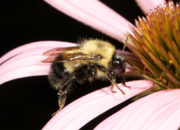One of the most abundant species in Vermont, especially in forested areas. Appears to be declining in some areas, especially in the western part of the state. Trends are complicated because this species is not reliably identifiable in most photos.
Identification: This group of the subgenus Pyrobombus has T1 and T2 both completely yellow with the rest of the abdomen black. Half-black is virtually indistinguishable from the much rarer Sanderson’s without a magnified view of the cheek.
Similar Species:
Sanderson’s Bumble Bee (Bombus sandersoni): Much rarer, but very similar. The best way to distinguish Sanderson’s and Half-black is the shape of the malar space (cheek). In Sanderson’s, the width is roughly equal to the length, whereas in Half-black, the length is slightly longer than the width. There is overlap, but Sanderson’s tends to have more black between the wings and queens often have white hairs on T5 and T6.
Perplexing Bumble Bee (Bombus perplexus): Similar to Half-black in that both species have yellow on T1 and T2. Perplexing Bumble Bees has a relatively distinctive hair color best described as egg yolk – darker and oranger than the pale yellow of most other bumble bees. Perplexing Bumble Bees lacks black between the wings but has noticeable black hairs below and behind the wings.
Global Status: Apparently Secure (G4)
Vermont Status: Secure (S5)
For more information, visit the following links:
Discover Life
Living Atlas Species Page
Distribution: Widespread in Vermont, as of April 2021, the map below was only showing a small subset of the 4,000+ plus records for this species. To see the global distribution, check out the iNaturalist account, and toggle the GBIF layer on the map.
 Kent McFarland
Kent McFarland






